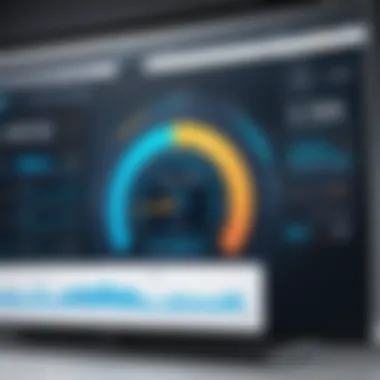Eero Speedtest Insights: Performance and Applications


Intro
In today's digital landscape, fast and reliable Wi-Fi is essential for both personal and professional environments. Eero, a notable player in the mesh networking system, has gained considerable attention for enhancing home and office connectivity. Performing speed tests on Eero devices can illuminate various aspects of network performance, helping users optimize their setup. This article provides a thorough examination of Eero speed testing methodologies, performance metrics, and significant factors that govern connectivity. By the end, IT professionals and tech enthusiasts will be equipped with valuable insights into managing and improving network efficiency.
Product Overview
Eero devices are designed to provide seamless internet connectivity throughout a space, eliminating dead zones commonly found with traditional routers. Understanding the products is crucial for effective speed testing.
Key Features
Eero offers several features aimed at optimizing user experience:
- Mesh Technology: This allows multiple Eero units to work in unison, creating a unified network.
- User-Friendly App: The Eero app simplifies setup and management of the network.
- Automatic Updates: Eero devices receive regular updates to improve performance and security.
- Parental Controls: This feature allows users to manage access to content and internet usage for different devices.
Technical Specifications
Analyzing the technical aspects of Eero products provides insight into their capabilities:
- Wi-Fi Standards: Eero supports both 802.11ac and 802.11ax standards, enabling high-speed connections.
- Ethernet Ports: Some Eero devices include Ethernet ports for wired connections.
- Beamforming Technology: This focuses the Wi-Fi signal towards connected devices for improved performance.
Performance Analysis
To effectively evaluate Eero devices, various performance metrics must be considered. This section delves into benchmark results and real-world usage scenarios.
Benchmark Test Results
Comparative speed tests provide concrete data on Eero's performance. Studies indicate that Eero consistently delivers:
- Download speeds averaging between 150-250 Mbps.
- Upload speeds fluctuating between 25-100 Mbps.
- Latency levels generally under 20 ms, optimizing online gaming and streaming experiences.
Real-World Usage Scenarios
To comprehend how Eero devices perform in diverse environments, real-world scenarios are analyzed. Examples include:
- Home Offices: Users report significant reductions in buffering during video calls and while accessing cloud applications.
- Gaming: High latency can ruin gaming experiences, but Eero's performance metrics show consistent speeds conducive to online gaming.
"Eero's mesh network has transformed my home office setup. I no longer struggle with weak signals or interrupted connections."
Understanding Eero Technology
Understanding Eero technology is crucial for grasping how these systems work and how they can be optimized for peak performance. In the context of this article, it lays the foundation for comprehension of network capabilities and the implications of speed testing. Eero systems utilize mesh networking, which provides numerous benefits over traditional routers. Such advantages include improved coverage, better handling of multiple devices, and seamless connectivity.
Overview of Eero Mesh Networking
Eero mesh networking is designed to eliminate dead spots and enhance the overall Wi-Fi experience in homes and offices. Unlike conventional routers that scatter signals unevenly, Eero's technology distributes signals more uniformly. This allows for consistent connectivity, regardless of the location of devices. The primary components of an Eero system include a main unit and additional nodes that communicate with each other and with connected devices. This creates a robust and responsive network.
It is also worth noting that the Eero system is user-friendly. Users can easily set up additional units through an intuitive app, which speeds up the installation process. The app provides real-time insights into network performance and device connectivity, making it more accessible for non-technical users.
Key Features of Eero Systems
Eero systems boast several key features that position them well in the competitive networking market. Some of the notable elements include:
- Automatic Updates: Eero systems are designed for longevity. They receive regular updates, which deliver new features and security enhancements without user intervention.
- TrueMesh Technology: This ensures optimal routing of data by dynamically choosing the best path for data packets. It minimizes latency and maximizes speed.
- Guest Network Capabilities: Users can create separate guest networks, enhancing security while allowing visitors to easily connect without sharing the main password.
- Integration with Smart Home Devices: Eero seamlessly integrates with various smart home devices, making it easier to manage a connected ecosystem.
Understanding these features not just enriches the knowledge of IT professionals and tech enthusiasts but also emphasizes the importance of choosing the right equipment based on specific demands.
"Eero has transformed home networking into an easily manageable task, allowing users to focus on their work and leisure without constant interruptions due to connectivity issues."
By understanding the core technology behind Eero, readers can better appreciate the relevance of speed testing as they evaluate network performance and optimize their setups.
The Importance of Speed Testing
Speed testing serves as an invaluable tool for assessing the performance of any network, including Eero systems. In today's digital age, where connectivity is crucial, understanding how your network behaves under various conditions can make a significant difference. Conducting speed tests helps identify potential issues, optimize settings, and enhance overall user experience.
The primary function of speed tests is to measure key performance indicators such as download speed, upload speed, and latency. These metrics provide a clear picture of how well your network is functioning. For IT professionals, speed tests offer critical insights that inform troubleshooting and optimization strategies. Additionally, they serve as a benchmark for comparing different network configurations or devices.
Why Speed Tests Matter
Speed tests matter for several reasons. First, they ensure that the performance promised by your Internet Service Provider is actually delivered. Many users subscribe to plans that guarantee certain speeds, yet real-world performance often falls short due to various factors. Conducting consistent speed tests allows users to confirm that they receive adequate service.


Second, speed tests identify bottlenecks within the network. Issues may arise from hardware limitations, incorrect configurations, or even environmental obstacles. For example, obstacles like walls and electronic interference can impede Wi-Fi signals. By pinpointing these issues through speed testing, users can make informed decisions on resource allocation and adjustments.
Third, they are essential for ensuring that technology implementations meet the changing demands of users. Digital tasks vary widely, from simple browsing to heavy data streaming. Regular speed tests allow IT professionals to adapt to these changing requirements, ensuring that networks support the necessary bandwidth for all use cases.
Common Misconceptions about Speed Tests
Despite their importance, several misconceptions about speed tests abound. One prevalent misunderstanding is that speed tests are only relevant for desktop users. In reality, mobile devices also require monitoring, as many users access the internet primarily through smartphones and tablets today. Ignoring mobile performance can lead to significant gaps in network effectiveness.
Another common myth is that speed tests provide instant results that always reflect real-world performance. However, results can vary based on testing conditions. Factors such as server location, time of day, and network congestion can influence outcomes. Therefore, it is advisable to conduct multiple tests across varying times to obtain a comprehensive understanding of network capabilities.
Conducting Eero Speedtests
Conducting speed tests on Eero devices is a critical activity for assessing network performance. Understanding the real-time capabilities of one's internet connection is essential for troubleshooting potential issues. For IT professionals and tech enthusiasts, these tests can offer valuable insights into how well Eero systems operate under various conditions. By analyzing the results from speed tests, users can identify performance bottlenecks and optimize their networks for better efficiency.
Step-by-Step Guide to Speed Testing
Required Tools
To conduct effective speed tests, certain tools are necessary. The most commonly used tool is a reliable speed test app or website, such as Ookla Speedtest or Fast.com. These platforms are favored for their accuracy and ease of use. A good characteristic of these tools is their ability to provide real-time data on download and upload speeds, as well as ping times.
A unique feature of these tools is their broad compatibility across devices. Whether using a laptop, smartphone, or tablet, the user can count on consistent performance. However, it is important to ensure that the selected tool is legitimate and not susceptible to advertising distractions that could mislead users about their true internet speeds.
Test Conditions
Test conditions play a pivotal role in obtaining accurate speed test results. It’s advisable to perform tests during various times of the day to gauge the effect of network congestion. A critical aspect of this is maintaining the same network environment, ensuring that no other devices are actively using bandwidth during the test.
A beneficial practice is to restart the modem and Eero devices before testing. This action can help clear any temporary issues affecting speed. The unique feature of consistent test conditions allows users to make informed comparisons over time. However, inconsistent variables, like background downloads, might skew results, leading to misinterpretation.
Execution Steps
The execution of speed tests involves straightforward steps. First, users should connect their device directly to their Eero network. Then, launching the speed test app or website is the next task. As the tests begin, paying attention to background activities can ensure that the results represent true performance.
An important aspect of execution is to repeat each test multiple times for reliability. Performing speed tests at different times and recording the results establishes a more comprehensive dataset for analysis.
Here are the steps in brief:
- Connect to the Eero network.
- Open the preferred speed test tool.
- Start the test and wait for results.
- Repeat the test multiple times.
Overall, this structured approach to execution provides robust data about network capabilities, helping users better understand how Eero devices perform under varying conditions.
Interpreting Speed Test Results
Interpreting speed test results is essential to fully understand network performance. Key metrics such as download speed, upload speed, and ping time provide insights into overall connectivity. For instance, a high download speed indicates that large files can transfer quickly, which is crucial for activities like streaming or gaming.
A common misconception is that higher speeds always equate to better performance. For example, latency issues can still arise even on fast connections, especially if ping times are high. Therefore, it is important to analyze all data points holistically.
Key takeaways for interpreting results include:
- Compare results against the service provider's claims.
- Look for patterns over multiple tests.
- Pay attention to fluctuations at different times of the day.
"Interpreting speed test results correctly is the key to leveraging Eero's full capabilities".
Factors Influencing Eero Speeds
Understanding the factors that influence Eero speeds is crucial for optimizing network performance and ensuring a smooth user experience. Eero, like any technology, can be impacted by various environmental, technical, and user-related factors. This section examines significant considerations that can affect the efficiency and speed of Eero networks. By identifying these factors, IT professionals can make informed decisions to enhance connectivity.
Network Congestion Considerations
Network congestion refers to the situation where network resources are overwhelmed by too much data traffic. This can significantly reduce the speeds experienced by users. Several key elements contribute to network congestion:
- Number of Active Devices: In any given network, the more devices that are connected, the higher the potential for congestion. Eero systems can support numerous devices, but as more devices connect and consume bandwidth, speeds may decline.
- High-Data Activities: Activities such as streaming videos, gaming, and large downloads can consume a lot of bandwidth, impacting overall performance. When multiple users engage in these activities simultaneously, the network can become strained.
- Peak Usage Times: Just like road traffic can fluctuate throughout the day, internet usage also peaks during certain hours. Understanding these peak times can help users adjust their activities to minimize congestion.
To mitigate these issues, consider scheduling high-bandwidth tasks during off-peak hours or implementing Quality of Service (QoS) settings to prioritize important traffic.
Impact of Device Limitations
Another factor influencing Eero speeds is the limitations of connected devices. Devices play a critical role in how quickly and effectively data travels through the network. Here are some device-related considerations:
- Age of Devices: Older devices often lack modern Wi-Fi capabilities. For instance, devices that only support Wi-Fi 4 will not achieve the speeds offered by Wi-Fi 5 or Wi-Fi 6 devices. Upgrading aging equipment can have a significant impact.
- Hardware Capabilities: Not all devices are built equally. Lower-end devices might not have the processing power or antenna configurations to effectively utilize available bandwidth. Thus, performance can greatly differ based on hardware quality.
- Software Updates: Regularly updating devices ensures they can communicate effectively with Eero systems. Sometimes, manufacturers release updates that improve compatibility and performance.


Environmental Factors Affecting Performance
The physical environment can also play a significant role in Eero performance. Understanding and managing these factors can improve connectivity:
- Obstacles: Walls, furniture, and other obstructions can interfere with Wi-Fi signals. Materials such as metal, concrete, and thick wood can weaken the signal drastically, regardless of the power of the Eero system.
- Interference from Other Electronics: Devices such as microwaves, cordless phones, and Bluetooth devices can interfere with Wi-Fi signals. Being aware of potential interference sources and positioning your Eero devices away from them can help maintain optimal performance.
- Distance from the Router: The further a device is from the Eero router, the weaker the signal becomes. Using additional Eero units to extend coverage can help eliminate dead zones and ensure better performance throughout the network.
By recognizing these influencing factors, users can take specific actions to enhance their Eero networks. Adjusting settings, updating devices, and optimizing layouts all play a part in achieving better speeds and ultimately, an improved user experience.
"Effective network management requires understanding the influence of various factors on performance. By addressing these considerations, one can significantly enhance overall connectivity."
In sum, addressing network congestion, device limitations, and environmental factors are vital for maintaining optimal Eero speeds.
Performance Benchmarks of Eero Systems
Understanding the performance benchmarks of Eero systems is essential for any user wanting to maximize their network efficiency. These benchmarks provide clarity on how well these devices perform under various conditions, revealing strengths and weaknesses that may affect overall user experience. By assessing the performance of Eero in comparison to competitor brands, users gain valuable insights that can inform their decisions about network design and implementation.
Detailed performance benchmarks help identify specific elements affecting connectivity. These include bandwidth capacity, response times, and the system's handling of multiple simultaneous connections. Users can, therefore, understand better what to expect from their Eero systems in different scenarios.
Comparative Analysis with Competitors
Conducting a comparative analysis between Eero and its main competitors reveals significant aspects about its performance. Brands like Google Nest WiFi and Netgear Orbi offer similar mesh networking solutions, but performance can vary widely based on real-world conditions. Users may examine factors such as:
- Maximum throughput: Eero systems generally offer competitive maximum speeds that closely rival those of competing systems.
- Latency: Eero tends to have low latency, improving the user experience for online gaming and video calls.
- Coverage area: The coverage provided by Eero systems is typically extensive, often surpassing that of alternative mesh systems.
By engaging in side-by-side comparisons, users can make informed decisions about which system may better suit their needs. Considerations about specific performance metrics may help in choosing a system that aligns with their usage patterns.
Real-World Performance Case Studies
Residential Use Cases
Residential use cases illustrate the practical benefits of Eero systems in everyday household settings. For families with multiple devices, the ability to manage bandwidth efficiently becomes critical. Eero stands out due to its automated network optimization features, which allocate bandwidth intelligently among connected devices.
One key characteristic of residential use cases is Eero's ease of installation. Many households appreciate a user-friendly setup, allowing owners to have their system operational within a short time. This accessibility is a major factor for first-time users.
However, some potential downsides include dependency on the Eero app for configuration. Users not comfortable with technology may face challenges in exploring advanced settings. But overall, the advantages often outweigh these minor inconveniences.
Small Business Implementations
Small business implementations of Eero systems display the product's versatility in professional environments. Business owners need reliability and coverage for numerous employees, and Eero delivers on those fronts effectively. One of the notable aspects of small business use is the capacity for secure guest networks, enabling visitors to access Wi-Fi without compromising internal security.
Another characteristic is the scalability of Eero solutions. Businesses can start with a basic setup and expand their network as they grow. This flexible approach proves beneficial for small enterprises serving fluctuating demands.
The major advantage lies in Eero's commitment to consistent software updates, keeping performance optimized over time. However, businesses operating in areas with heavy network congestion may face challenges, as congestion can affect performance. Overall, the system's adaptability and robust performance make it a valuable choice for small businesses seeking reliable networking solutions.
"Eero's technology not only enhances my internet experience but also effectively manages our office network with minimal downtime."
Understanding performance benchmarks, combined with comparative analyses and case studies, offers IT professionals and tech enthusiasts a nuanced perspective on Eero systems. These insights are vital to achieving optimum performance.
Optimizing Eero Performance
In the realm of network setups, optimizing Eero performance has become a pivotal concern for both IT professionals and tech enthusiasts. With the increasing reliance on stable and fast internet connections for both personal and professional use, understanding how to fine-tune Eero systems is crucial. Optimizing performance ensures that users experience minimal lag and maximum throughput, which directly enhances productivity and online experiences.
The benefits of optimizing Eero performance include not only increased speed but also improved reliability and extended range of coverage. A well-configured Eero system can accommodate high bandwidth demands without faltering. Moreover, considerations such as device placement, handling interference, and consolidated configurations play an essential role in achieving peak performance.
Best Practices for Configuration
Optimal configuration of an Eero system lies at the heart of any performance enhancement strategy. Here are some best practices:
- Proper Placement of Nodes: Position Eero units in strategic locations throughout your environment. Avoid placing them in enclosed spaces or near electronic devices that may cause interference. The optimal distance between nodes can significantly affect signal strength and consistency.
- Firmware Updates: Regularly updating the Eero system’s firmware is vital. These updates often come with enhancements that can improve overall system performance, addressing any security vulnerabilities in the process.
- Prioritize Bandwidth: Use the Eero app to prioritize devices that require more bandwidth for better performance. Devices such as streaming media players or gaming consoles can be assigned higher bandwidth when needed.
- Adjusting Wi-Fi Channels: If experiencing congestion, changing Wi-Fi channels can alleviate interference from neighboring networks. Using the Eero app, users can see and select the least congested channels available.
Enhancing Wi-Fi Coverage and Speed
To further bolster Wi-Fi coverage and speed, several approaches can be employed:
- Mesh Networking Optimization: Take advantage of the mesh capabilities of Eero. Make sure all Eero devices communicate effectively to extend coverage without loss in speed. A well-balanced mesh network decreases dead zones markedly.
- Minimize Interference: Keep Eero devices away from appliances and metal objects that can hinder signal quality. Checking for interference sources can lead to better overall performance.
- Use Ethernet Backhaul: For larger setups, consider utilizing Ethernet backhaul by connecting Eero units through wired connections. This method reduces the wireless load and often improves speed and reliability.
"Regular optimization of the Eero system ensures alignment with the latest technology demands, allowing users to stay ahead of potential connectivity issues."
- Feedback & Monitoring: Systems such as Eero provide real-time monitoring of network performance. Use this data to identify patterns and optimize accordingly. Taking note of user feedback regarding device performance can also offer valuable insights into areas needing attention.


By following these best practices and enhancements, users can ensure that their Eero systems operate at peak performance. This not only contributes to a seamless experience but also empowers users to leverage their technologies more effectively in their daily operations.
Future Trends in Eero Technology
The realm of Eero technology is rapidly evolving, as advancements dictate new methods for providing seamless connectivity. Understanding future trends in this space is crucial for IT professionals and tech enthusiasts alike. These developments not only need to be observed but also embraced, as they may greatly enhance network performance and efficiency. This section will delve into the expected upgrades and shifts in the industry that could reshape how Eero devices function.
Upcoming Features and Enhancements
Eero systems are constantly under evolution. New features are expected to improve user experience and efficiency. Some noteworthy upcoming enhancements include:
- Advanced Parental Controls: These will allow users more granular control over internet access for various devices, enabling them to manage online safety for children effectively.
- Integration with Smart Home Devices: Eero will likely expand compatibility with more smart home ecosystems, enhancing user convenience and overall utility.
- Improved AI and Machine Learning Capabilities: Future firmware updates can potentially bring AI-driven insights. This can aid in optimizing network performance, adjusting bandwidth allocation in real-time based on usage patterns.
- Next-Generation Wi-Fi Standards: Transitioning to Wi-Fi 6E will become a key enhancement, allowing for significantly faster speeds and better management of multiple devices on a home network.
These features promise to enhance the overall functionality, making Eero systems not just routers but smart network management tools.
Predicted Industry Shifts
As Eero technology advances, broader industry trends will also likely impact its development. Some anticipated shifts include:
- Shift Towards Subscription Models: The industry may see a movement towards service-based subscription models for software updates and customer support. This could allow for continuous enhancements to security and features without a full hardware upgrade.
- Increased Focus on Cybersecurity: With rising concerns about data privacy and online threats, Eero may introduce new security protocols and features. Protecting both personal data and home network integrity is imperative.
- Expansion of 5G Technology: The ongoing rollout of 5G networks is bound to influence how devices connect and interact. Eero systems may start integrating 5G capabilities, providing faster internet access even in more rural or underserved areas.
- Collaboration with Internet Service Providers: There might be an increase in partnerships between Eero and ISPs for better service offerings. This could facilitate improved internet performance and customer service.
"The future of Eero technology is promising, with innovations set to streamline connectivity and enhance user security."
Security Considerations for Eero Networks
In the digital age, securing network systems is crucial. Eero networks are no different. Using mesh networking architecture like Eero brings a variety of benefits, including improved range and connectivity. However, it also introduces distinct security risks that require attention. Understanding these risks is essential for users looking to safeguard their networks against unauthorized access and malicious activities.
Also, as more devices connect to home networks, the potential entry points for cyberattacks increase. Thus, discussions around security considerations for Eero networks are vital in ensuring not just performance, but also the safety of data transmitted across the network. This section will explore specific threats and offer solutions to mitigate them.
Threat Assessment in Mesh Networking
Mesh networks face unique security challenges that standard networks might not encounter. These challenges often come from their design. In a mesh network, multiple nodes work together to extend coverage. If one node is compromised, it could provide a pathway for attackers to access the entire network.
Some common threats include:
- Unauthorized Access: Attackers often try to breach networks to gain access to sensitive information. Eero networks need strong authentication methods to prevent this.
- Malware Infections: Devices on the network can be infected with malware, spreading the risks to other devices connected to the same network.
- Denial of Service Attacks: Attackers may flood a mesh network with excessive requests, hindering its performance and accessibility.
Assessing these threats is the first step. Users should regularly monitor network security settings and ensure they run updated software to minimize vulnerabilities.
Furthermore, educating users on the risks is vital. Many users may not realize their networks are always at risk of attack. Informational programs can increase awareness and equip them with knowledge to protect their systems.
Best Security Practices for Users
Ensuring the security of Eero networks involves implementing effective best practices. Following these recommendations can enhance protection against potential threats:
- Change Default Passwords: Default usernames and passwords are commonly known. Changing them can significantly reduce unauthorized access risks.
- Enable Two-Factor Authentication: This adds an extra layer of security. Even if a password is compromised, additional verification can protect access.
- Keep Firmware Updated: Eero regularly releases updates that fix security vulnerabilities. Keeping the firmware up to date is crucial to maintaining security and performance.
- Network Segmentation: Separating devices, such as IoT gadgets, from primary devices can minimize risks. If IoT devices are compromised, the primary devices remain secure.
- Regularly Monitor Network Activity: Users should check the devices connected to their network. If any unfamiliar devices appear, investigate immediately.
- Use a VPN: Utilizing a Virtual Private Network encrypts data traffic, making it more difficult for unauthorized users to track online activities.
"Security is not a product, but a process." - Bruce Schneier.
Implementing these best practices allows users to maximize their Eero network's security while enjoying connectivity benefits. Regular evaluations of network security should be part of any IT professional's routine. This ensures a proactive stance against the ever-evolving landscape of cyber threats.
User Testimonials and Experiences
Understanding user experiences and testimonials is crucial in evaluating the performance of Eero networking devices. These real-life accounts provide insights that go beyond conventional metrics. They highlight how Eero behaves in diverse environments with various users. Testimonials from actual users and industry professionals reflect the strengths and weaknesses of Eero systems, making them a rich source of information for both prospective and current users.
The collective experiences shared by users can shed light on practical applications and help identify recurring issues. Such narratives offer a perspective not typically captured in theoretical studies. They frame technology as it exists in the hands of users, thereby guiding others who might face similar situations or challenges.
User testimonials can also expose potential gaps between expectations and reality. Some users may report excellent connectivity in their homes, while business users might highlight challenges faced during peak usage times. This diversity in experiences can inform decisions on configuration or highlight the need for better network management practices.
Feedback from IT Professionals
IT professionals offer a unique viewpoint regarding Eero systems based on their technical understanding and hands-on experience. Their feedback can be invaluable when assessing the practical performance of Eero devices.
Often, IT professionals provide insights on how well Eero integrates into existing networks. For instance, they may discuss:
- Ease of Deployment: Many IT professionals report that Eero devices are user-friendly and often require minimal setup time, which is beneficial in commercial environments.
- Performance in Demanding Situations: Their feedback typically covers the reliability of the devices under high loads. They might specifically examine how Eero performs during simultaneous streaming or online gaming sessions.
- Support and Resources: Professional users often evaluate the quality of Eero's technical support and available online resources. Prompt and effective customer service is a vital aspect that can determine overall user satisfaction.
Ultimately, the feedback from IT professionals aids in evaluating not just the hardware, but the overall ecosystem surrounding Eero systems as well.
Real-life Issues and Solutions
While Eero provides a robust networking solution, no technology is without its challenges. Real-life issues reported by users often highlight practical challenges and prompt solutions that can enhance overall performance.
Common issues include:
- Connectivity Drops: Some users report intermittent connectivity. Solutions often involve checking the placement of Eero devices and ensuring they are within range of one another to maintain effective communication within the mesh network.
- Speed Throttling During Peak Times: Users may experience slower speeds at busy times. IT professionals recommend assessing device limits and configuring Quality of Service (QoS) settings to prioritize critical traffic.
- Configuration Misunderstandings: New users might struggle with settings. Providing clear guidance and resources can mitigate confusion. This can include sharing links to Eero's official support pages where users can find setup guides and troubleshooting tips.
Learning from user testimonials, both positive and negative, many individuals gain practical wisdom that enhances their experience with Eero systems. Identifying issues through user feedback and discussing solutions with peers can facilitate better outcomes and improved user experiences.



